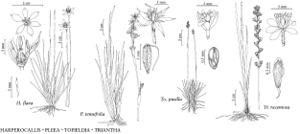Triantha
J. Linn. Soc., Bot. 17: 490. 1879.
| Taxon | Illustrator ⠉ | |
|---|---|---|
 | Harperocallis flava Pleea tenuifolia Tofieldia pusilla Triantha racemosa | Yevonn Wilson-Ramsey Yevonn Wilson-Ramsey Yevonn Wilson-Ramsey Yevonn Wilson-Ramsey |
Herbs, perennial, rhizomatous. Stems glandular and/or glandular-pubescent. Leaves mostly basal with 0–3 towards stem base, 2-ranked, equitant; blade linear. Inflorescences terminal, racemose, open or dense and spikelike, elongating in fruit, bracteate, bracteolate; bracteoles connate in epicalyx. Flowers borne in clusters of 2–7; tepals persistent, 6, in 2 somewhat dissimiliar series, distinct; stamens 6; filaments strongly flattened, dilated basally; anthers basifixed, 2-locular, introrse, without appendages; ovary superior, stipitate, apocarpous basally, glabrous; intercarpellary nectary present; styles 3. Fruits capsular, ovoid to broadly ellipsoid or cylindrical, glabrous, dehiscence septicidal, then adaxially loculicidal. Seeds appendaged. x = 15.
Distribution
North America, Japan
Discussion
Species 4 (3 in the flora).
Recognition here of the genus Triantha follows J. G. Baker (1879) and R. R. Gates (1918); see J. G. Packer (1993). R. W. Cruden (1991) provided cladistic evidence supporting this segregation from Tofieldia.
In the absence of any clear understanding of evolutionary relationships within Triantha, the species are here listed alphabetically.
Selected References
None.
Lower Taxa
Key
| 1 | Styles connate basally into column 1/4–2/3 their length; capsules hard, ± equaling or slightly longer than tepals and ± enclosed by them. | Triantha racemosa |
| 1 | Styles distinct to base, not forming column; capsules chartaceous and easily ruptured, considerably longer than tepals and not enclosed by them. | > 2 |
| 2 | Seed coat present; inflorescence sometimes forming globose head (subsp. occidentalis); glandular hairs on stem below inflorescence sometimes uniformly 4–6 times longer than wide (subsp. montana); w Canada, nw United States. | Triantha occidentalis |
| 2 | Seed coat absent; inflorescence never forming globose head; glandular hairs on stem below inflorescence never uniformly 4–6 times longer than wide; widespread in Canada, also in Alaska, some north, northeastern states, and Oregon. | Triantha glutinosa |
"broad" is not a number."elongating" is not a number."thicker" is not a number.